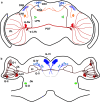A comparative view of insect circadian clock systems
- PMID: 20035363
- PMCID: PMC11115600
- DOI: 10.1007/s00018-009-0232-y
A comparative view of insect circadian clock systems
Abstract
Recent studies revealed that the neuronal network controlling overt rhythms shows striking similarity in various insect orders. The pigment-dispersing factor seems commonly involved in regulating locomotor activity. However, there are considerable variations in the molecular oscillatory mechanism, and input and output pathways among insects. In Drosophila, autoregulatory negative feedback loops that consist of clock genes, such as period and timeless are believed to create 24-h rhythmicity. Although similar clock genes have been found in some insects, the behavior of their product proteins shows considerable differences from that of Drosophila. In other insects, mammalian-type cryptochrome (cry2) seems to work as a transcriptional repressor in the feedback loop. For photic entrainment, Drosophila type cryptochrome (cry1) plays the major role in Drosophila while the compound eyes are the major photoreceptor in others. Further comparative study will be necessary to understand how this variety of clock mechanisms derived from an ancestral one.
Figures


Similar articles
-
Circadian photoreception in Drosophila: functions of cryptochrome in peripheral and central clocks.J Biol Rhythms. 2001 Jun;16(3):205-15. doi: 10.1177/074873040101600303. J Biol Rhythms. 2001. PMID: 11407780
-
Knockout of cryptochrome 1 disrupts circadian rhythm and photoperiodic diapause induction in the silkworm, Bombyx mori.Insect Biochem Mol Biol. 2024 Sep;172:104153. doi: 10.1016/j.ibmb.2024.104153. Epub 2024 Jul 2. Insect Biochem Mol Biol. 2024. PMID: 38964485
-
An extraretinally expressed insect cryptochrome with similarity to the blue light photoreceptors of mammals and plants.J Neurosci. 1999 May 15;19(10):3665-73. doi: 10.1523/JNEUROSCI.19-10-03665.1999. J Neurosci. 1999. PMID: 10233998 Free PMC article.
-
A fly's eye view of circadian entrainment.J Biol Rhythms. 2003 Jun;18(3):206-16. doi: 10.1177/0748730403018003003. J Biol Rhythms. 2003. PMID: 12828278 Review.
-
Genetics and molecular biology of rhythms in Drosophila and other insects.Adv Genet. 2003;48:1-280. doi: 10.1016/s0065-2660(03)48000-0. Adv Genet. 2003. PMID: 12593455 Review.
Cited by
-
Disease-Associated Mutant Tau Prevents Circadian Changes in the Cytoskeleton of Central Pacemaker Neurons.Front Neurosci. 2020 Mar 27;14:232. doi: 10.3389/fnins.2020.00232. eCollection 2020. Front Neurosci. 2020. PMID: 32292325 Free PMC article.
-
Exposure to Artificial Light at Night and the Consequences for Flora, Fauna, and Ecosystems.Front Neurosci. 2020 Nov 16;14:602796. doi: 10.3389/fnins.2020.602796. eCollection 2020. Front Neurosci. 2020. PMID: 33304237 Free PMC article. Review.
-
Uncovering the circadian transcriptome of Nasonia vitripennis: insights into a non-canonical insect model.Proc Biol Sci. 2024 Nov;291(2035):20241848. doi: 10.1098/rspb.2024.1848. Epub 2024 Nov 27. Proc Biol Sci. 2024. PMID: 39591997 Free PMC article.
-
Mated Drosophila melanogaster females consume more amino acids during the dark phase.PLoS One. 2017 Feb 27;12(2):e0172886. doi: 10.1371/journal.pone.0172886. eCollection 2017. PLoS One. 2017. PMID: 28241073 Free PMC article.
-
A circadian clock drives behavioral activity in Antarctic krill (Euphausia superba) and provides a potential mechanism for seasonal timing.Elife. 2025 Apr 29;14:RP103096. doi: 10.7554/eLife.103096. Elife. 2025. PMID: 40298939 Free PMC article.
References
-
- Dunlap JC, Loros J, DeCoursey PJ. Chronobiology: biological timekeeping. Sunderland: Sinauer; 2004.
-
- Saunders DS. Insect clocks. Amsterdam: Elsevier; 2002.
-
- Tomioka K, Chiba Y. Characterization of optic lobe circadian pacemaker by in situ and in vitro recording of neuronal activity in the cricket Gryllus bimaculatus . J Comp Physiol A. 1992;171:1–7. doi: 10.1007/BF00195955. - DOI
-
- Fleissner G. Isolation of an insect circadian clock. J Comp Physiol. 1982;149:311–316. doi: 10.1007/BF00619146. - DOI
Publication types
MeSH terms
Substances
LinkOut - more resources
Full Text Sources
Molecular Biology Databases

